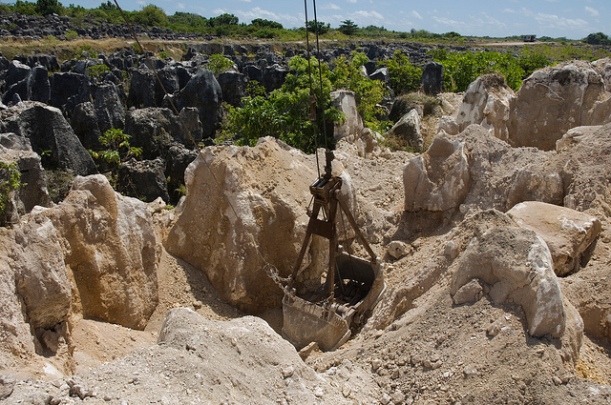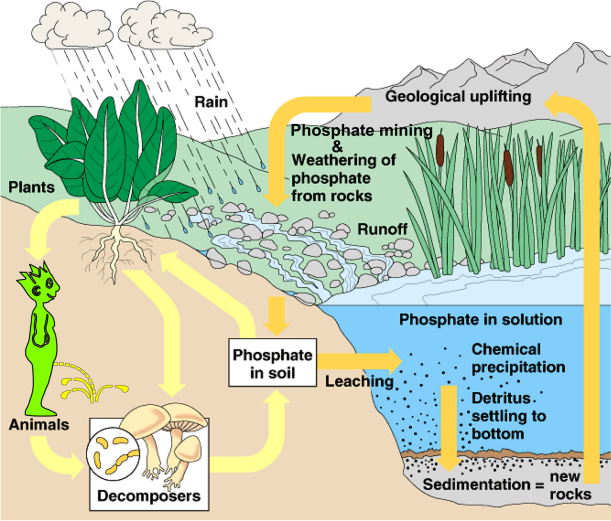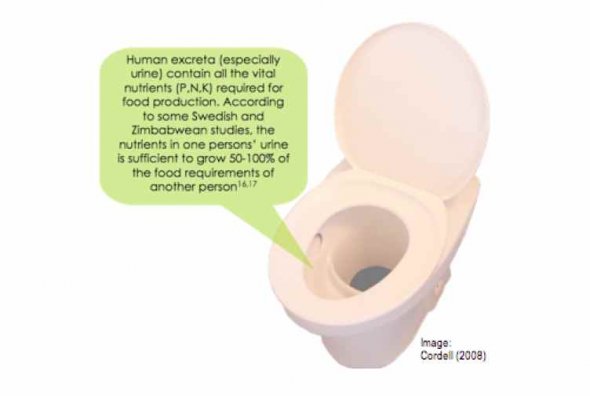Since my post about nitrogen fertilizer is still one of the most successful ones yet (who’d thought?), and I’ve been working non-stop this week on a paper to analyze phosphorus and its resource, phosphate rock, for a paper in my class Economic Growth and Sustainable Development, I thought I’d give you some insights into what I learned. Sit tight, since there are definitely a couple of things you’ll be surprised by…
1. First off, you’ll remember that there are three macronutrients that are needed for plant growth – nitrogen (N), phosphorus (P) and potassium (K). A German chemist called Justus von Liebig actually discovered this in the 1840s; before, people thought that plants got their energy somewhat mysteriously from other plants and animals decomposing in the soil which would transfer their life onward – but then came organic chemistry and people rejoiced at a quick and easy formula to make their plants grow better – just add N, P, and K! In fact, with these three (and some would argue, additional nutrients like sulphur), there is always one limiting factor that inhibits additional growth. As one of the papers I read said, “fertilisers do not make plants grow, but rather it is the lack of the nutrients they contain, or an imbalance in supply, that can prevent the plant from expressing its full productive potential“. In the 1840s and 1850s, this limiting factor was phosphorus. According to the same paper, “if the commercial manufacturing process for phosphatic fertiliser had not been discovered in the 1840s, life in the UK and in other industrialised countries would have become unsustainable. The global population which was threatened by a lack of soil fertility in 1850 was less than 1.5 billion; by 2050 this may have grown to 9.2 billion, all of whom will depend on a sustainable solution to the supply of nutrients to soils to replace those removed at harvest.“
2. But even before people knew about macronutrients, they were fertilizing their fields – in fact, fertilization has occurred for as long as agriculture exists. Sometimes, people (e.g. the Aboriginal tribes in Australia) would burn fields regularly to bring nutrients back to the soil; other cultures would use animal droppings (manure) or in the Middle East during the Roman era people used to keep pigeons not only for meat, but also for their droppings. This discovery would actually come back en vogue in the 19 century when farmers started importing guano – bird and bat droppings that had solidified over centuries on remote islands like those off the coast of Peru (another fascinating topic – Wikipedia tells me wars were fought over guano control!). What might be most surprising is that Chinese farmers for centuries used something they called ‘night soil’ – human feces – as a really useful fertilizer. Even Victor Hugo wrote in Les Miserables: “Science, after having long groped about, now knows that the most fecundating and the most efficacious of fertilizers is human manure. The Chinese, let us confess it to our shame, knew it before us. Not a Chinese peasant goes to town without bringing back with him, at the two extremities of his bamboo pole, two full buckets of what we designate as filth. Thanks to human dung, the earth in China is still as young as in the days of Abraham. Chinese wheat yields a hundred fold of the seed.” Keep that in mind. We’ll get back to it.

Image by DFAT Australian Aid, via Flickr CC.
3. You see, the thing is, no life could exist without phosphorus. It’s an element that is necessary for human, animal, plant and even bacteria survival (remember ATP, those things you learned in biology that gave you energy? Adenosine-tri-phosphate? Yup.). So are nitrogen and potassium, but phosphorus is different, because it is actually a non-renewable resource just like fossil fuels. At least for human time scales. While nitrogen can be manufactured (though that requires tons of energy which again might be dependent on fossil fuels, but let’s leave that out for a second) basically from thin air, and we don’t have to worry about running out of potassium anytime soon, phosphorus cycles through the earth rather than through the air, meaning that its life cycles can easily span millennia. Right now, we are getting most of our phosphorus from phosphate rock (this is the resource that I wrote my paper on). This is phosphorus that has solidified over centuries and made mountains – and we are taking it out of the earth again and throwing it onto our soils. And then flushing it down the toilet – many times, literally. (Again, more on that later.)
4. Should we be concerned about our phosphate rock reserves? Here comes the funny thing. Until around 2010, the literatures basically says HELL YES. At the current rates of use, researchers had predicted that ‘peak phosphorus’ (in an analogy to peak oil, the point after which we will be able to extract less and less each year) was supposed to occur around 2030 – 2040 and the total global reserves to last another 99 years. Let me repeat that – really important resource for human survival. Best-known resource. Will last another 99 years. Cue panic? But then Morocco suddenly updated their data, and all of a sudden, instead of a predicted 16 billion tonnes left (reports of 2010), we have a predicted 67 billion tonnes. Yup, Morocco just added 50 billion tonnes to their grand total. No big deal. How reliable is this estimate? Depends on who you ask, but most of the scientists that were concerned before didn’t really stop, sit back and relax if you know what I mean. One article says that they view these new numbers with “considerable caution”.
5. That is the other thing – phosphate rock is potentially a geopolitically very interesting resource. Only 5 countries control around 85% of global total reserves – the US, China, Morocco, Jordan and South Africa. Most of Morocco’s reserves are actually located in the Western Sahara, a territory to which they lay claim but which is technically illegally occupied by them. And many other countries – including most of Europe – is 100% dependent on imports of phosphorus, since they don’t have any own mines. During the 2008 – 2009 crisis, prices for phosphorus spiked like crazy – following food prices – but there was little consumers could do but pay up because in the short run everybody just needs the fertilizer. Also, China imposed a 135% export tariff to keep its phosphate rock to its own food production (it is in fact the largest consumer of phosphate fertilizers), so it’s definitely becoming a resource people get touchy about, and will only be more so in the future. Except if we just added 50 billion tonnes. But maybe we didn’t.
6. Either way, the way we treat phosphorus right now is inherently wasteful. What most scientists are concerned with is that we have developed a throughput model rather than a cycle, as had been the case over most of human history. See, while we do need phosphorus to survive, we don’t actually take up that much of it – nor nitrogen, for that matter. Most of it, we pee and poo right back out; which is why the Chinese night soil worked so well. Fun fact:
So technically, we could just go round in a circle, right? Especially if we add in animal manure as well? (Because – major DUH moment for me, this is why animal manure is such good fertilizer as well. Same principle. What goes in comes out 😉 ) But while this often happened in the past, two major consecutive revolutions broke this cycle. First, the Sanitation Revolution, and then the Green Revolution. First, for the sake of hygiene and public health and as urbanization progressed, we started to have water-based disposal of human waste rather than the previous land-based one, where nutrients would be recycled by necessity. Now, nitrogen and phosphorus are rather flushed in the sea – causing dead zones and eutrophication, and maybe even more direly for the phosphorus balance, diluting the phosphorus we just mined from the mountains so far that we will have to wait until it settles at the bottom of the ocean as sediment and becomes another mountain to be able to reuse it – that might just take a while. Second, the Green Revolution and mixed mineral fertilizer came along, which speeded up phosphorus use just as we were no longer recycling it – especially after World War II and simultaneously with the nitrogen breakthrough, phosphate rock came to be mined in increasing quantities to put on fields around the world and spur growth. Now, phosphorus ceased to be the limiting nutrient and nitrogen became the limiting factor – but because most fertilizers are made up of a mix of N, P, and K, P use just grew at approximately the same level (though after the 1960s the ratio of nitrogen compared to P and K increased somewhat). And we keep going and going and using it and using it.
7. However, here comes the good news – unlike nitrogen, which runs off through leaching super easily, phosphorus actually remains in the soil (unless it is washed away with it as happens during erosion) and thus the previous years’ overuse was somewhat of an investment, if you so will – now most soils in the developed world require lower P application than a couple of decades ago, and we could actually improve our P-use efficiency significantly. There is still going to be increasing demand from transitioning and developing countries, though. But as it stands, it seems that the entire process is extremely wasteful and could be easily made more efficient – lots of potential there!

8. Second, there is some real potential for innovative solutions that close the human P(ee)-cycle (I really wanted to make that joke in my paper too and didn’t end up doing it – thank goodness I have a blog, it’s too good to pass up on it!) Those include urine-diverting toilets like the one in the picture above which, in a centralized system, could end up saving tons of phosphorus just through saving the urine (which is very sterile) separately from the feces (which is more problematic regarding hygiene and the spread of pathogens). I also found this discussion (from this paper) super interesting:
It is particularly important that developing countries re-examine their aspirations for ‘western-style’ sewage treatment solutions, and not automatically adopt the ‘water carriage central end-of-pipe treatment’ paradigm, which is among the most expensive and energy intensive components of modern public infrastructure (Abeysuriya et al., 2006). This ‘once through’ paradigm was designed to solve the emerging disease and pollution problems of Victorian London and other 19th century Industrial Revolution cities; however, it is not necessarily the optimal solution for the 21st century developing world, or in the developed world as aging infrastructure systems become due for replacement. Alternatives such as decentralized systems, waste-stream separation at source, and ‘improved’ centralized systems should be considered (Abeysuriya et al., 2006); the focus should be on recovering water, heat energy, carbon, nitrogen and especially phosphorus, to once again ‘close the circle’ and become truly sustainable.
While I’d been confronted with the topic of proper human waste treatment rather frequently in discussions of public health and development, I guess I never really questioned the paradigm of having a water-based waste treatment system, but rather despaired at the financial and infrastructural hurdles. Now seeing the dots connected, I guess it really doesn’t make that much sense after all. In fact, another paper said that we could fulfill 22% of global phosphorus demand if we properly recycled human waste – and would in addition avoid the pollution of waterways. Here, one man’s trash is truly another man’s treasure.
9. According to the same article, the demand for phosphorus is predicted to increase by 50– 100% by 2050 with increased global demand for food and changing diets. Here, the same principle applies as for climate-friendly diets – the more direct plant-based food you eat, the more ‘phosphorus-friendly’ your diet is, because you are requiring less crops to be grown (and fertilized) for the same amount of calories than if you are more carnivorous. Thus, one major step forward for more phosphorus security is a less meat-heavy diet – unfortunately not where our planet seems to be headed at the moment.
10. Finally, a sentence that made me smile: “A study of Swiss citizens found a rather high willingness to both use urine-diverting toilets and to consume food fertilized by urine“. Those poor research assistants that had to go out and explain this to people over and over. Or maybe not? In general, I find that our inhibition in talking about pee and poo might just be really misguided, especially if it has such a vital role to play in placing us within the circle of life. (Got that song stuck in your head? Me too. Let’s just listen to it.)
Did you know about where phosphorus came from before reading this? Are you worried we’ll run out of it? What do you think of talking more openly about pee and poo?

Thanks for this post, it’s just great! 🙂
Thanks for reading! 😉
Wow, what a great post! Lots of information here that keeps one’s thinking fresh! Thanks for sharing 😀
Reblogged this on AgroEcoPeople and commented:
Some great analysis on P/ee for thought… err, Food Policy for Thought!
You might be interested in the interconnection of Liebig and Marx’s ideas (http://urbanag.pbworks.com/f/FosterMagdoff.pdf). They were mutual fans, iirc, though skimming through some old articles, I only see proof that Marx was Liebig’s fan. Liebig did, however, write “The American farmer despoils his field without the least attempt at method in the process? When it ceases to yield him sufficiently abundant crops, he simply quits it, and with his seeds and plants, betakes himself to a fresh field ; for there is plenty of good land to be had in America ; and it would not be worth his while to work the same field to absolute exhaustion. But our modern system of ” high farming” is an organised system of spoliation — ^the last, highest, and most finished degree of the art of wearing out
the soil. ” (https://archive.org/stream/lettersonmoderna00lieb/lettersonmoderna00lieb_djvu.txt)
Foster and Magdoff have further noted that Liebig advocated, yes, using mined and synthetic elements, but also admonished the Lord Mayor of London about the “Utilization of Municipal Sewage”, the lack of recycling in agricultural systems, and the lack of city-country connections; indeed, Engels summarized him thusly: “The abolition of the antithesis between town and country is no more and no less utopian than the abolition of the antithesis between capitalists and wage-workers. From day to day it is becoming more and more a practical demand of both industrial and agricultural production. No one has demanded this more energetically than Liebig in his writings on the chemistry of agriculture, in which his first demand has always been that man shall give back to the land what he receives from it, and in which he proves that only the existence of the towns, and in particular the big towns, prevents this. When one observes how here in London alone a greater quantity of manure than is produced in the whole kingdom of Saxony is poured away every day into the sea with an expenditure of enormous sums, and what colossal structures are necessary in order to prevent this manure from poisoning the whole of London, then the utopia of abolishing the distinction between town and country is given a remarkably practical basis.” (http://monthlyreview.org/2013/12/01/marx-rift-universal-metabolism-nature)
This is a really great post! I am a botanist, and knew of the need for P but didn’t give much thought to where we get it. This seems to mirror the shortage we will face with helium. Although the helium crisis is already upon us….only the public hasn’t heard.